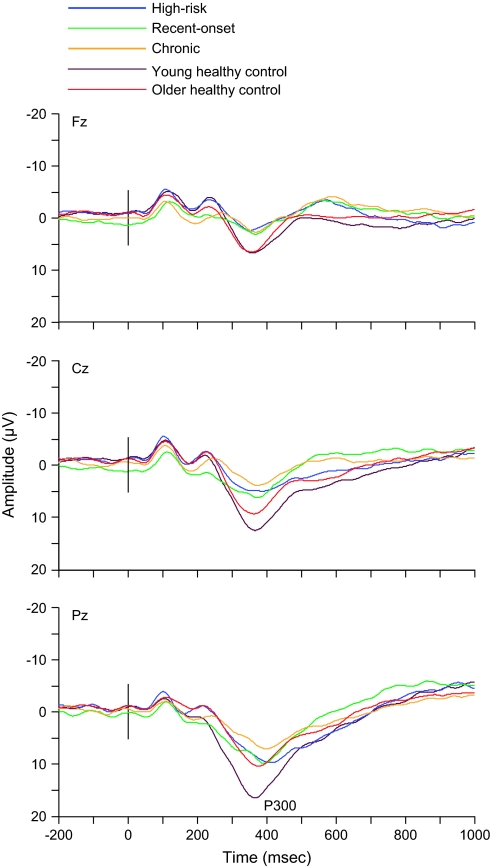Fig. 2.
Group mean event-related potentials (ERPs) elicited by auditory target stimuli recorded at midline frontal (Fz), central (Cz), and parietal (Pz) scalp locations, superimposed for subjects at high risk for schizophrenia (n = 10; mean age = 22.1 years, SD = 4.3), subjects with recent-onset schizophrenia (n = 10; mean age = 21.3 years, SD = 3.2; mean illness duration = 0.6 years, SD = 0.3), subjects with chronic schizophrenia (n = 14; mean age = 37.5 years, SD = 7.5; mean illness duration = 12.2 years, SD = 6.8), young healthy control subjects (n = 14; mean age = 22.5 years, SD = 2.0) who are age matched to the high-risk and recent-onset groups, and older healthy control subjects (n = 14; mean age = 34.1 years, SD = 10.9) who are age matched to the chronic patient group. The ERPs were collected while subjects performed an auditory oddball task. The auditory stimuli were pure sinusoidal tones (100-ms duration, 10-ms rise/fall), consisting of frequent standard stimuli (1000-Hz tones, P = 91.5%) and infrequent deviant or target stimuli (1064-Hz tones, P = 8.5%), presented binaurally through inserted earphones in a random order using a constant interstimulus interval of 1500 ms. Study participants were instructed to pay attention to the auditory stimuli and to make a button-press response only to the infrequent target stimuli, emphasizing both speed and accuracy. P300 refers to the late scalp-positive ERP component associated with target detection. High-risk, recent-onset, and chronic schizophrenia patient groups all showed significantly smaller P300 amplitudes at Pz and/or Cz relative to healthy age-matched control subjects. Older healthy control subjects displayed significantly smaller P300 amplitudes at Pz compared with younger healthy control subjects. Reprinted with permission from Schizophr Res.,64 Copyright 2005, Elsevier.

